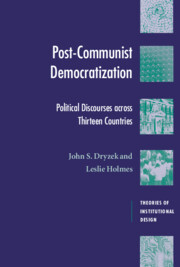4 - Yugoslavia
Published online by Cambridge University Press: 22 September 2009
Summary
Contemporary Yugoslavia dates only from the 1990s. It is all that remains of a much larger Yugoslavia created after the First World War as the Kingdom of Serbs, Croats, and Slovenes (under Serbian King Peter), although it also included Bosnia, Hercegovina, Montenegro, and parts of Macedonia. The new country was renamed Yugoslavia (Land of the Southern Slavs) in 1929. There was a limited form of parliamentary democracy during the 1920s. But this was short-lived, and the country became a virtual dictatorship under King Alexander in 1929. (For a claim that democracy in Serbia was well developed prior to the First World War, but usually overlooked in histories of the period, see Suster, 1998.)
There had been ethnic tensions within Yugoslavia from its earliest days, particularly between the two largest groups, Croats and Serbs. These reached a peak during the Second World War, when the fascist Ustaše declared a separate Croatia (which included parts of Bosnia and Hercegovina). The Serbian position was more complex. The new anti-fascist Yugoslav government fled into exile in London in 1941, while Serbia itself was controlled partly by the Serbian nationalist Chetniks. In 1943, the Western allies discovered that many (though not all) Chetniks were collaborating with the Nazis. Given the existence of a fascist state in Croatia, and the fact that the London government-in-exile had little real power within Yugoslavia, the West increased support for Josip Broz Tito's communists.
- Type
- Chapter
- Information
- Post-Communist DemocratizationPolitical Discourses Across Thirteen Countries, pp. 57 - 76Publisher: Cambridge University PressPrint publication year: 2002

